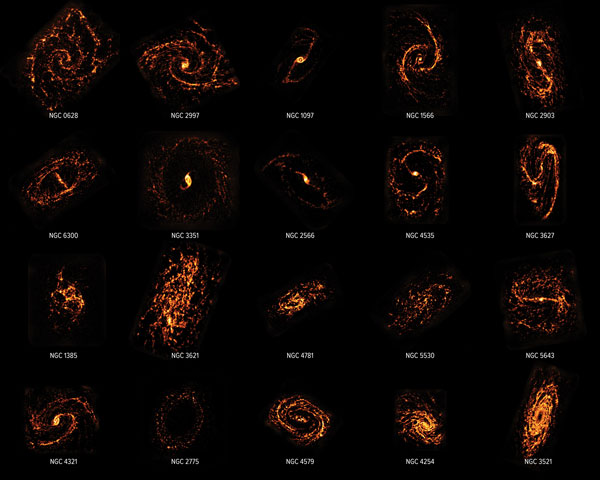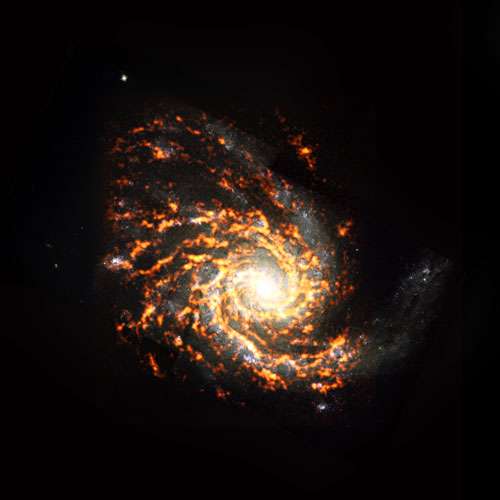Astronomers have created the first high-resolution maps of the big, dense gas clouds that form stars within galaxies.
Astronomers from around the world have worked together to create the first high-resolution maps of the big, dense gas clouds that form stars inside galaxies. Results from their survey of 90 nearby galaxies indicate that our understanding of star formation is incomplete.
The astronomers are part of the Physics at High Angular Resolution in Nearby Galaxies (PHANGS) collaboration. PHANGS used several instruments, including the Atacama Large Millimeter/submillimeter Array (ALMA) in Chile, to observe star-forming galaxies of all shapes and sizes in the nearby universe. They used these data, taken over five years, to study the properties of 40,000 molecular clouds with an unprecedented level of coverage and resolution.
Molecular clouds are regions of dense gas and dust that serve as the birthplace of stars. Often referred to as stellar nurseries, these regions can form up to tens of thousands of stars during their million-year lifetimes. Previously, astronomers thought that all molecular clouds were essentially the same, but this new study shows that the characteristics of these clouds can vary with their location in their host galaxy.
“This is important because if molecular clouds vary systematically, then their star-formation activity is also likely to depend on where they live,” said PHANGS collaborator Annie Hughes (Research Institute in Astrophysics and Planetology, France) during a June 8th press conference at the virtual summer meeting of the American Astronomical Society.

Credit: ALMA (ESO/NAOJ/NRAO)/PHANGS, S. Dagnello (NRAO)
Carbon Monoxide in Molecular Clouds
The PHANGS-ALMA branch of the project makes galactic maps using emission from carbon monoxide (CO) molecules. “This is our main way to trace the cold dense molecular gas that, as far as we understand, forms all stars in the local universe,” said collaborator Adam Leroy (Ohio State University) during his June 7th presentation at the same meeting.
ALMA’s spatial resolution makes it possible to observe structures on the scale of about 300 light-years, which happens to be the approximate size of an individual cloud. Such data are a significant improvement on past observations, as there were previously only a handful of external galaxies with well-studied cloud populations.
The CO data show that the mass, density, and turbulence of a given cloud depends on its local environment. Clouds found towards a galaxy’s center tend to be more turbulent and dense than their counterparts living in the outskirts of galactic arms. “These variations appear to be linked to changes in the star-formation activity and in the evolution of those clouds, which strongly suggests that star formation does not happen everywhere the same way across and among galaxies,” Hughes said.
Stellar Implications
The causes for this diversity depend on both large and small-scale factors. Combining the CO data with observations of older stars indicates that gas within a cloud appears to clump in response to the galaxy’s underlying stellar structure, said collaboration member Sharon Meidt (Gent University, Belgium) in a June 9th presentation. This correlation is surprising, she explained, because at the scale of an individual cloud, astronomers had expected only what was going on inside the gas to matter.
The mass and density of a given cloud may change how long it survives before exhausting its star-forming materials. However, the relationship between molecular clouds and star formation is not straightforward – a more massive cloud does not necessarily make more stars. Studies have shown that molecular clouds are inefficient at forming stars, converting only 1% of their gas mass into a final stellar product. Current theories posit that turbulence inside the cloud should influence star birth, such that violent clouds create stars more efficiently. However, PHANGS results show the opposite to be true, noted team member Dyas Utomo (National Radio Astronomy Observatory, Charlottesville) in his June 9th talk. Some other stealthy factors, such as the amount of dense gas within the cloud, must be at play.

Credit: ALMA (ESO/NAOJ/NRAO) / PHANGS, S. Dagnello (NRAO)
As for the future, the PHANGS team would like to look at other molecules that trace the dense knots within molecular clouds from which stars originate. This is currently in the works with other PHANGS iterations that use the Hubble Space Telescope and the Very Large Telescope in Chile to look at a subset of these 90 galaxies. Such observations will help the PHANGS team constrain how quickly and efficiently stars form in different environments.
The PHANGS data are publicly available and, along with more than 30 papers that are in the works, Leroy expects many more to come from the scientific community at large.
 1
1









Comments
Yaron Sheffer
June 11, 2021 at 9:59 am
And no two galaxies are ever the same! Each galaxy is an individual configuration of many billions of interacting components, yielding an astonishing variety. They are like snow flakes that precipitated from the Big Bang, or like fingerprints all over the celestial sphere...
You must be logged in to post a comment.
You must be logged in to post a comment.